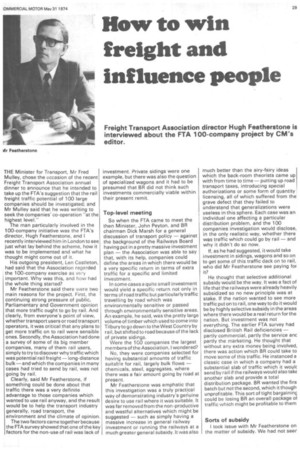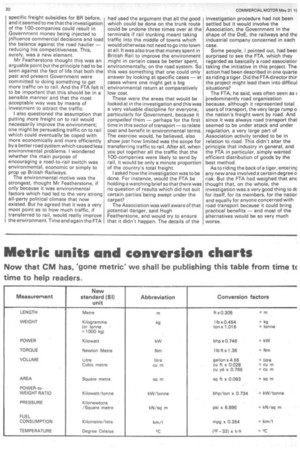How to win freight and influence people
Page 31

Page 32

If you've noticed an error in this article please click here to report it so we can fix it.
THE Minister for Transport, Mr Fred MuIley, chose the occasion of the recent Freight Transport Association annual dinner to announce that he intended to take up the FTA's suggestion that the rail freight traffic potential of 100 large companies should be investigated; and Mr MuIley said that he was writing to seek the companies' co-operation "at the highest level."
The man particularly involved in the 100-company initiative was the FTA's director, Hugh Featherstone, and I recently interviewed him in London to see just what lay behind the scheme, how it was to be implemented and what he thought might come out of it.
His outgoing president, Len Castleton, had said that the Association regarded the 100-company exercise as very important. Why was this, and how had the whole thing started?
Mr Featherstone said there were two main reasons for the project. First, the continuing strong pressure of public, Parliamentary and Government opinion that more traffic ought to go by rail. And clearly, from everyone's point of view, whether transport users or road transport operators, it was critical that any plans to get more traffic on to rail were sensible ones. Secondly, the Association had done a survey of some of its big member companies, many of them rail users, simply to try to discover why traffic which was potential rail freight long-distance bulk — and which the companies in many cases had tried to send by rail, was not going by rail.
Clearly, said Mr Featherstone, if something could be done about that traffic there was a very definite advantage to those companies which wanted to use rail anyway, and the result would be to help the transport industry generally, road transport, the environment and the climate of opinion.
The two factors came together because the FTA survey showed that one of the key factors for the non-use of rail was lack of investment. Private sidings were one example, but there was also the question of specialized wagons and it had to be presumed that BR did not think such investments commercially viable within their present remit.
Top-level meeting
So when the FTA came to meet the then Minister, John Peyton, and BR chairman Dick Marsh for a general discussion of transport policy — against the background of the Railways Board having put in a pretty massive investment plan — the Association was able to say that, with its help, companies could define the areas in which there would be a very specific return in terms of extra traffic for a specific and limited investment.
In some cases a quite small investment would yield a specific return not only in terms of road traffic but particularly traffic travelling by road which was environmentally sensitive or passed through environmentally sensitive areas. An example, he said, was the pretty large volume of timber which used to come into Tilbury to go down to the West Country by rail, but shifted to road because of the lack of private sidings.
Were the 100 companies the largest members of the Association, I wondered?
No, they were companies selected for having substantial amounts of traffic suitable for rail, largely bulk flows — chemicals, steel, aggregates, where there was a fair amount going by road at present.
Mr Featherstone was emphatic that this investigation was a truly practical way of demonstrating industry's genuine desire to use rail where it was suitable. It was far removed from the non-productive and wastful alternatives which might be suggested — such as simply having a massive increase in general railway investment or running the railways at a much greater general subsidy. It was also much better than the airy-fairy ideas which the back-room theorists came up with from time to time — putting up road transport taxes, introducing special authorizations or some form of quantity licensing, all of which suffered from the grave defect that they failed to understand that generalizations were useless in this sphere. Each case was an individual one affecting a particular distribution problem, and the 100 companies investigation would disclose, in the only realistic way, whether there was traffic which could go by rail — and why it didn't do so now.
If, as he had suggested, it would take investment in sidings, wagons and so on to get some of this traffic deck on to rail, who did Mr Featherstone see paying for it?
He thought that selective additional subsidy would be the way. It was a fact of life that the railways were already heavily subsidized so no new principle was at stake. If the nation wanted to see more traffic put on to rail, one way to do it would be by highly selective subsidy in the areas where there would be a real return for the nation. But investment was not everything. The earlier FTA survey had disclosed British Rail deficiencies — partly commercial, partly the service anc partly the marketing. He thought that without any extra money being involved, there was action which BR could take to move some of this traffic. He instanced a classic case in which a company had a substantial slab of traffic which it woulc send by rail if the railways would also take another slab and provide a total distribution package. BR wanted the firs batch but not the second, which it though. unprofitable. This sort of tight bargaininc could be losing BR an overall package o1 traffic which might be profitable to them
Sorts of subsidy
I took issue with Mr Featherstone on the matter of subsidy. We had not seer specific freight subsidies for BR before, and it seemed to me that the investigation of the 100-companies could result in Government money being injected to influence commercial decisions and load the balance against the road haulier — reducing his competitiveness. This, surely, was a new element.
Mr Featherstone thought this was an arguable point but the principle had to be seen against the fact of life that both the past and present Government were committed to doing something to get more traffic on to rail. And the FTA felt it to be important that this should be in a sensible manner and that the most acceptable way was by means of investment to attract the traffic.
I also questioned the assumption that putting more freight on to rail would necessarily improve the environment; one might be persuading traffic on to rail which could eventually be coped with more economically and more efficiently by a better road system which caused less environmental problems. I wondered whether the main purpose of encouraging a road-to-rail switch was environmental, economic or simply to prop up British Railways.
The environmental motive was the strongest, thought Mr Featherstone, if only because it was environmental factors which had led to the very strong all-party political climate that now existed. But he agreed that it was a very moot point as to how much traffic, if transferred to rail, would really improve the environment. Time and again the FTA had used the argument that all.the good which could be done on the trunk route could be undone three times over at the terminals if rail trunking meant taking traffic into the middle of towns which would otherwise not need to go into town at all. It was also true that money spent in British Rail to improve the environment might in certain cases be better spent, environmentally, on the road system. So this was something that one could only answer by looking at specific cases — at cases where one might get a big environmental return at comparatively low cost.
These were the areas that would be looked at in the investigation and this was a very valuable discipline for everyone, particularly for Government, because it compelled them — perhaps for the first time in this sector of transport—to relate cost and benefit in environmental terms. The exercise would, he believed, also show just how limited was the scope for transferring traffic to rail. After all, when you put together all the traffic that the 100-companies were likely to send by rail, it would be only a minute proportion of the country's total freight.
I asked how the investigation was to be done. For instance, would the FTA be holding a watching brief so that there was no question of results which did not suit certain parties being swept under the carpet?
The Association was well aware of that potential danger, said Hugh Featherstone, and would try to ensure that it didn't happen. The details of the investigation procedure had not been settled but it would involve the Association, the Government in the shape of the DoE, the railways and the industrial company concerned in each case.
Some people, I pointed out, had beer surprised to see the FTA, which they regarded as basically a road associatior taking the initiative in this project. The action had been described in one quarte as riding a tiger. Did the FTA director thin the project might lead them into difficul situations?
The FTA, he said, was often seen as predominantly road organization because, although it represented total users of transport, the very large rump o the nation's freight went by road. And since it was always road transport that seemed to be under attack and under regulation, a very large part of Association activity tended to be in relation to road. This didn't alter the principle that industry in general, and the FTA in particular, simply wanted efficient distribution of goods by the best method.
As to riding the back of a tiger, enterinc any new area involved a certain degree o risk. But the FTA had weighed that anc thought that, on the whole, the investigation was a very good thing to dc for itself, for its members, for the natior and equally for anyone concerned with road transport because it could bring practical benefits — and most of the alternatives would be so very much worse.




























































































